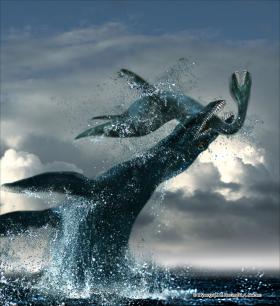
It’s hard to imagine that oceans in the far north once teemed with ancient marine reptiles. But 145 million years ago, that’s exactly what was happening a couple hundred miles north of mainland Europe. A region east of Greenland and north of Norway used to be home to a whole slew of giant sea-faring reptiles. “It is literally one of the richest places in the world for marine reptiles like Plesiosuars and Ichthyosuars,” says Pat Druckenmiller. He’s the Earth Science Curator at the University of Alaska, Fairbanks Museum of the North. His latest work on Svalbard was recently published in a large volume of the Norwegian Journal of Geology.
Druckenmiller is a member of the Spitsbergen International Research Group. It includes geologists, sedimentologists and other scientists who’ve spent the past seven years digging up ancient marine reptiles on Svalbard, a group of Norwegian islands above the Arctic Circle. “So what we were really doing there wasn’t just looking at marine reptiles but getting a big picture view of the whole ecosystem,” he says. “What were the ocean conditions like, what was the water depth, what was the water temperature, what kind of invertebrates were living in the sea at the same time that may have been at the base of the food chain for marine reptiles so we really took a big picture approach.”
Druckenmiller just wrapped up his seventh field season. To be fair, Svalbard, was located further south, by about ten degrees latitude during the Late Jurassic – a geologic period that begin 160 million years ago. Back then, the region was slightly warmer. It’s home to what Druckenmiller calls a “bonanza” of giant reptiles. “We’re not really sure why it’s so rich. That’s sort of still the million dollar question,” he explains. “What we focused on is ok, let’s take advantage of the fact that it’s so rich and document the new types of things we find here and low and behold really almost all the material we uncovered turned out to be new species,” says Druckenmiller.
There are two major groups of marine reptiles from this period: Plesiosaurs and Ichthyosaurs. Since 2006, the group has excavated 37 enormous skeletons of each from a band of rock that spans four million years. “37 skeletons over seven field seasons to put that in perspective, I would estimate that there have been probably not much more than 20 skeletons excavated in the rest of the world anywhere else,” he says. “It also means that this process of discovery is going to be going on literally for years to come as that material gets cleaned up and we start to examine it in new light,” says Druckenmiller.
At least six of the skeletons represent new species. Two of them come from a Pliosaur – a type of Plesiosuar. It was a 40 foot-long, top marine predator. “This animal has a skull that would have been two and half meters, in other words six to seven feet long just the skull with teeth larger in diameter than the teeth of a t-rex,” he explains. “So this was the consummate underwater predator this was the animal that all others quivered at the presence of. We also named three new types of long-necked Plesiosaur, the ones that looked like the mythical Loch Ness monsters. One of them was pretty incredible because it had 60 vertebrae in its neck.” … In other words, that Plesiosaur’s neck was eight feet long. It’s the longest neck ever discovered from an animal living during the Jurassic anywhere in the world.
All of the material uncovered on Svalbard is currently housed at the University of Oslo in Norway. The team will clean the bones and make molds and casts of them. While the field work has come to an end for the time being, Druckenmiller says that doesn’t mean the project is complete.
“I would estimate we easily have another ten years of fossil preparation just to see what we have. Plus as we’re uncovering that material it often takes a year or two of work just to properly document and describe… so it’s a slow process and I suspect I’ll be working on this material for another twenty years of my career so that will keep me busy for quite a while,”he laughs.
Druckenmiller says it’s likely the group will head back to Svalbard to continue digging in a few years. He says it’s quite possible at least one of the marine reptiles discovered could make its way to Fairbanks one day.
For even more photos of Druckenmiller’s and the rest of the team’s work, click here: http://www.nhm.uio.no/om/presse/foto/svalbard/




